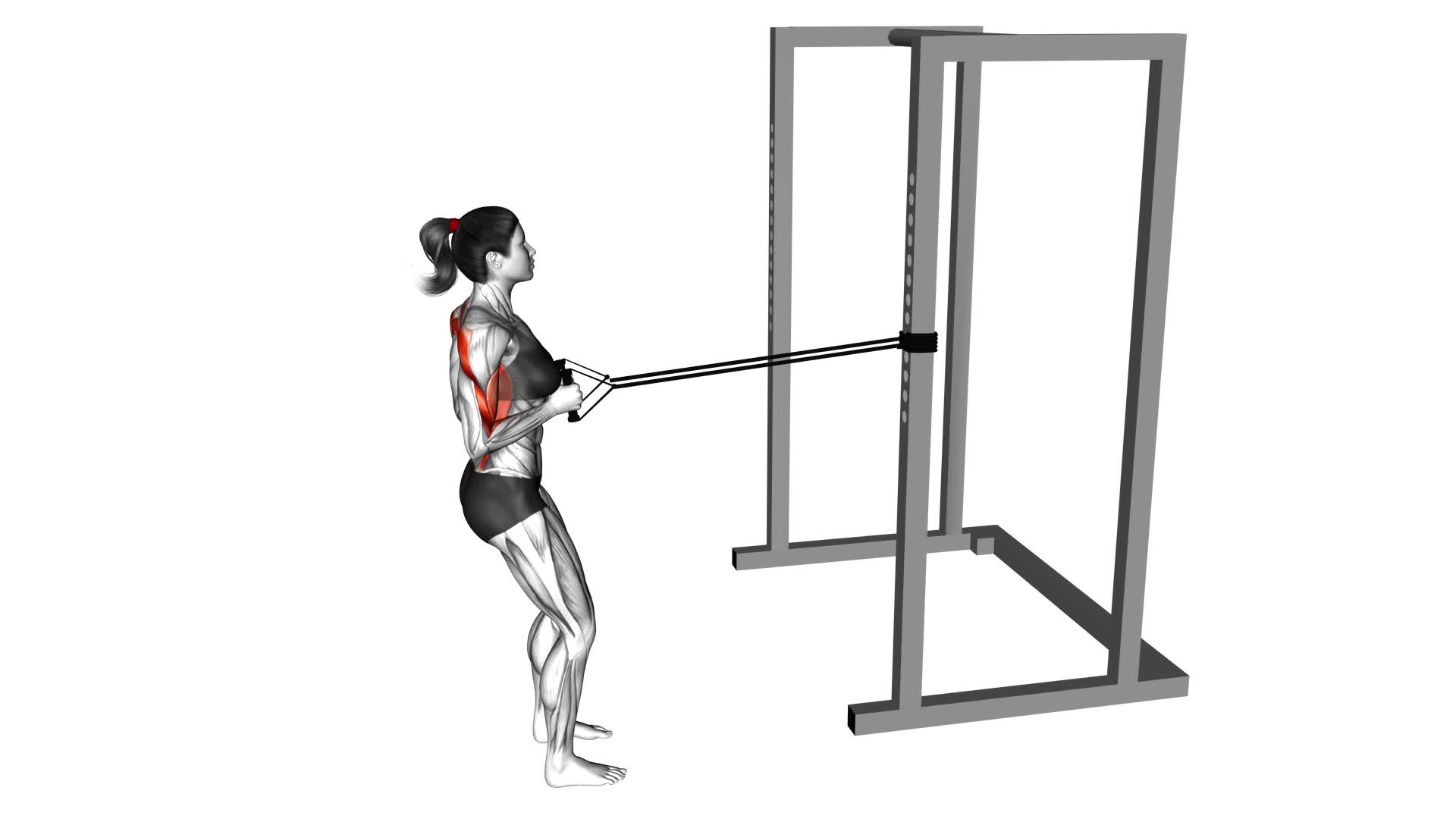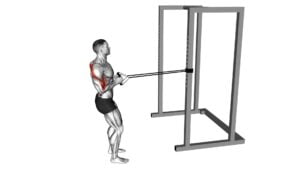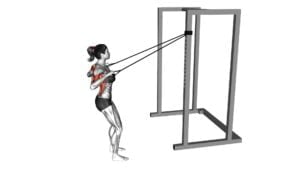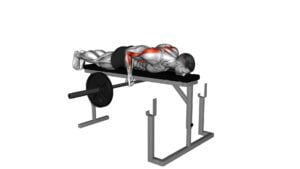Band Close Grip Row (female) – Video Exercise Guide & Tips

Get ready to take your workout to the next level with the Band Close Grip Row. This exercise is perfect for females looking to build strength and tone their upper body.
Watch This Exercise Video
In this video exercise guide, you'll learn the proper form and technique, as well as how to adjust the resistance for your fitness level. Avoid common mistakes and discover variations and progressions to keep challenging yourself.
Incorporate the Band Close Grip Row into your routine and see the results you've been working for.
Key Takeaways
- The Band Close Grip Row is an effective exercise for increasing upper body strength and targeting the back, shoulders, and arms.
- Proper form and technique, including maintaining body alignment, grip strength, and control, are crucial for maximizing muscle engagement and preventing injury.
- Grip strength and control can be improved through exercises such as Farmer's Walk, Plate Pinch, Hand Grippers, Wrist Curls, and Finger Extensions.
- It is important to avoid common mistakes such as relying on biceps instead of engaging back muscles, rounding or arching the spine, and performing fast and uncontrolled movements.
Benefits of the Band Close Grip Row
One benefit of the Band Close Grip Row is increased upper body strength. This exercise utilizes band resistance, which adds an extra challenge to your workout. By using resistance bands, you can target your back, shoulders, and arms more effectively, leading to improved strength in these muscle groups.
The Band Close Grip Row specifically targets the muscles in your upper back, including the rhomboids, trapezius, and rear deltoids. As you pull the resistance band towards your body, these muscles work together to control the movement and generate force. Over time, this exercise can help you develop a stronger and more defined upper back.
In addition to targeting the upper back, the Band Close Grip Row also engages the biceps and forearms. As you pull the band towards your body, your biceps contract to assist in the movement. This can lead to increased strength and muscle definition in your arms.
Proper Form and Technique
To perform the Band Close Grip Row with proper form and technique, it's important to focus on body alignment during the exercise. Keep your back straight and engage your core to maintain stability throughout the movement.
Additionally, pay attention to your grip strength and control, ensuring that you maintain a firm hold on the band throughout the exercise.
Body Alignment During Exercise
Maintain proper body alignment during the Band Close Grip Row exercise by engaging your core and keeping your back straight. Proper body posture is crucial to ensure that you're effectively targeting the muscles and minimizing the risk of injury.
Start by standing with your feet shoulder-width apart and your knees slightly bent. Engage your core muscles by pulling your belly button towards your spine. Throughout the exercise, focus on keeping your back straight and avoid arching or rounding your spine. This will help you maintain stability and prevent strain on your lower back.
By maintaining proper body alignment, you'll maximize muscle engagement and get the most out of your Band Close Grip Row workout.
Now, let's move on to the importance of grip strength and control.
Grip Strength and Control
When performing the Band Close Grip Row exercise, it's important to focus on maintaining a strong grip and controlling the movement of the band. Improving your grip strength and hand control is crucial for maximizing the benefits of this exercise.
Here are five exercises that can help you achieve better grip strength and control:
- Farmer's Walk: Grab a pair of heavy dumbbells and walk for a set distance or time.
- Plate Pinch: Hold a weight plate between your fingers and thumb, and try to lift it off the ground.
- Hand Grippers: Squeeze hand grippers together to strengthen your grip.
- Wrist Curls: Use a dumbbell or barbell and perform wrist curls to target the muscles in your forearms.
- Finger Extensions: Use a rubber band or finger extensor to strengthen your finger muscles.
Incorporating these exercises into your routine will help you develop a stronger grip and better control over the band during the Band Close Grip Row exercise.
Avoiding Common Mistakes
To ensure proper form and technique while performing the Band Close Grip Row (female) exercise, you should focus on avoiding common mistakes.
One common mistake is using your biceps instead of your back muscles to pull the band. Remember to engage your back muscles by squeezing your shoulder blades together while pulling the band towards your torso.
Another mistake is rounding your back during the exercise. Keep your back straight and maintain a slight bend in your knees to prevent any strain on your lower back.
Additionally, make sure to maintain a controlled and slow movement throughout the exercise, avoiding any jerking or swinging motions.
Adjusting Resistance for Your Fitness Level
Choosing the appropriate resistance level is crucial for effectively performing the Band Close Grip Row exercise. Adjusting the resistance allows you to modify the intensity of the exercise to match your fitness level. Here are some tips on adjusting the resistance for your fitness level:
- Start with a light resistance band if you're new to strength training or have limited upper body strength.
- Increase the resistance by using a thicker band or adding more bands if the exercise feels too easy.
- If the exercise feels too challenging, decrease the resistance by using a thinner band or removing one or more bands.
- Listen to your body and find a resistance level that challenges you without causing pain or discomfort.
- As you progress and become stronger, gradually increase the resistance to continue challenging your muscles.
Common Mistakes to Avoid
To maximize the effectiveness of the Band Close Grip Row exercise and prevent potential injuries, it's important to be aware of common mistakes to avoid while performing this exercise. By avoiding these mistakes and focusing on proper form, you can ensure that you're targeting the right muscles and getting the most out of your workout.
One common mistake to avoid is using too much momentum. It can be tempting to use your body's momentum to complete the rowing motion, but this takes away from the effectiveness of the exercise. Instead, focus on using your back muscles to pull the band towards your body, engaging them fully throughout the movement.
Another mistake to watch out for is rounding your shoulders. This can put unnecessary strain on your neck and upper back. To improve your form, make sure to keep your shoulders pulled back and down throughout the exercise. This will help to maintain proper alignment and reduce the risk of injury.
Lastly, be mindful of your grip. Avoid gripping the band too tightly, as this can cause unnecessary tension in your forearms and wrists. Instead, maintain a firm but relaxed grip to allow for proper muscle activation.
By avoiding these common mistakes and focusing on improving your form, you can maximize the effectiveness of the Band Close Grip Row exercise.
Now, let's move on to the next section to explore variations and progressions of this exercise.
Variations and Progressions
To continue building on your progress and challenging your muscles, there are several variations and progressions you can explore for the Band Close Grip Row exercise. These variations will help you add variety to your workouts and target different muscle groups. Here are some options to consider:
- Single-arm Band Close Grip Row: Perform the exercise with one arm at a time, focusing on each side independently. This variation increases the challenge and helps improve unilateral strength and stability.
- Band Close Grip Row with Resistance: Attach a heavier resistance band or add resistance bands to increase the intensity of the exercise. This variation provides a greater challenge for your muscles.
- Band Close Grip Row with Pause: Pause for a few seconds at the top of each repetition to increase the time under tension and further engage your back muscles.
- Band Close Grip Row with Tempo: Perform the exercise with a slower tempo, focusing on the eccentric (lowering) phase. This variation adds an extra challenge to your muscles and enhances muscle control.
- Band Close Grip Row with Isometric Hold: At the top of each repetition, hold the position for a few seconds before lowering the band. This variation helps improve muscle endurance and stability.
By incorporating these variations into your routine, you can continue to challenge your muscles and avoid hitting a plateau.
Now, let's explore how to incorporate the band close grip row into your workout routine.
Incorporating the Band Close Grip Row Into Your Workout Routine
To incorporate the Band Close Grip Row into your workout routine, start by selecting a resistance band that challenges your muscles but still allows you to maintain proper form. Resistance bands are a versatile and effective tool for incorporating into your upper body strength training. They provide constant tension throughout the movement, engaging your muscles and helping you build strength.
Once you have chosen the appropriate resistance band, you can begin incorporating the Band Close Grip Row into your workout routine. Begin by attaching the band to a sturdy anchor point, such as a door or a stationary object. Stand facing the anchor point and hold the handles of the band with a close grip, palms facing each other.
To perform the exercise, keep your back straight, engage your core, and pull the band towards your torso, squeezing your shoulder blades together. Focus on using your back muscles to initiate the movement, rather than relying solely on your arms. Slowly return to the starting position and repeat for the desired number of reps.
Incorporating the Band Close Grip Row into your upper body strength training routine can help you develop a stronger back, improve posture, and enhance overall upper body strength. Remember to start with a resistance band that challenges your muscles appropriately, and gradually increase the resistance as your strength improves.
Frequently Asked Questions
How Many Sets and Reps Should I Do for the Band Close Grip Row?
To determine how many sets and reps you should do for the band close grip row, it's important to consider your fitness level and goals. The band close grip row is a great exercise for improving upper body strength. It targets your back, biceps, and shoulders.
As for the sets and reps, a good starting point would be 3 sets of 10-12 reps. However, it's always best to consult with a fitness professional for personalized guidance.
Can I Use a Resistance Band With Handles Instead of a Loop Band for This Exercise?
Yes, you can definitely use a resistance band with handles instead of a loop band for the band close grip row exercise. Both types of bands will provide resistance and target your muscles effectively.
The main difference is the grip and how you hold the bands. With handles, you'll have a more secure and comfortable grip. Just make sure to adjust the tension of the band accordingly.
Is the Band Close Grip Row Suitable for Beginners?
The band close grip row is a good exercise for building back muscles. It targets the rhomboids, trapezius, and latissimus dorsi.
It can be modified for different fitness levels by adjusting the resistance of the band. Beginners can start with a lighter band and gradually increase the resistance as they get stronger.
Remember to maintain proper form and engage your core throughout the exercise.
Consult with a fitness professional if you have any concerns or questions.
Can I Perform This Exercise Without a Resistance Band?
Yes, you can perform the close grip row exercise without a resistance band.
However, using a resistance band has several benefits for strength training. It adds resistance to your muscles, increasing the intensity of the exercise.
Additionally, resistance bands allow for variations in the close grip row, such as using different band tensions or incorporating other equipment. These variations can target different muscle groups and provide a more well-rounded workout.
Can the Band Close Grip Row Help Improve My Posture?
The band close grip row is a great exercise to improve your posture. By targeting the muscles in your back and shoulders, it helps strengthen and align your upper body.
To perform it with proper form, start by attaching a resistance band to a stable anchor. Then, grip the band with your hands close together and pull it towards your body, squeezing your shoulder blades together.
Keep your back straight and core engaged throughout the movement.
Conclusion
The band close grip row is an effective exercise for strengthening the back muscles and improving posture. By using a resistance band, you can easily adjust the intensity level to suit your fitness level.
It's important to maintain proper form and avoid common mistakes to maximize the benefits of this exercise. With variations and progressions, you can continue challenging yourself and achieving new fitness goals.
Incorporate the band close grip row into your workout routine for a stronger back and improved overall fitness.

Author
Years ago, the spark of my life’s passion ignited in my mind the moment I stepped into the local gym for the first time. The inaugural bead of perspiration, the initial endeavor, the very first surge of endorphins, and a sense of pride that washed over me post-workout marked the beginning of my deep-seated interest in strength sports, fitness, and sports nutrition. This very curiosity blossomed rapidly into a profound fascination, propelling me to earn a Master’s degree in Physical Education from the Academy of Physical Education in Krakow, followed by a Sports Manager diploma from the Jagiellonian University. My journey of growth led me to gain more specialized qualifications, such as being a certified personal trainer with a focus on sports dietetics, a lifeguard, and an instructor for wellness and corrective gymnastics. Theoretical knowledge paired seamlessly with practical experience, reinforcing my belief that the transformation of individuals under my guidance was also a reflection of my personal growth. This belief holds true even today. Each day, I strive to push the boundaries and explore new realms. These realms gently elevate me to greater heights. The unique combination of passion for my field and the continuous quest for growth fuels my drive to break new ground.



